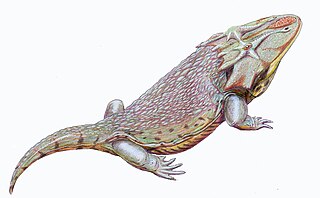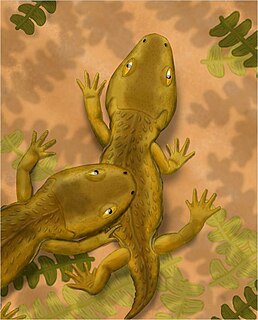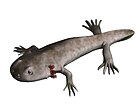
Compsognathus is a genus of small, bipedal, carnivorous theropod dinosaur. Members of its single species Compsognathus longipes could grow to around the size of a turkey. They lived about 150 million years ago, during the Tithonian age of the late Jurassic period, in what is now Europe. Paleontologists have found two well-preserved fossils, one in Germany in the 1850s and the second in France more than a century later. Today, C. longipes is the only recognized species, although the larger specimen discovered in France in the 1970s was once thought to belong to a separate species and named C. corallestris.
Friedrich von Huene, full name Friedrich Richard von Hoinigen was a German paleontologist who renamed more dinosaurs in the early 20th century than anyone else in Europe. He also made key contributions about various Permo-Carboniferous limbed vertebrates.

Zatracheidae is a family of Late Carboniferous and Early Permian temnospondyl amphibians known from North America and Europe. Zatracheidids are distinguished by lateral (sideways) bony protuberances of the quadratojugal bone of the skull, and a large opening in the snout called the internarial fontanelle that is bordered by enlarged premaxillae. The skull is flattened, with small orbits or eye sockets set far back. The opening in the snout may have housed a gland for producing a sticky substance so that prey would adhere to the tongue. If so, this indicates that these animals spent a large part of their time on land.

Palaeosaurus is a genus of indeterminate archosaur known from two teeth found in either the Magnesian Conglomerate or the Avon Fissure Fill of Clifton, Bristol, England. It has had a convoluted taxonomic history.

Sphenacodon is an extinct genus of synapsid that lived from about 300 to about 280 million years ago (Ma) during the Late Carboniferous and Early Permian periods. Like the closely related Dimetrodon, Sphenacodon was a carnivorous member of the Eupelycosauria family Sphenacodontidae. However, Sphenacodon had a low crest along its back, formed from blade-like bones on its vertebrae instead of the tall dorsal sail found in Dimetrodon. Fossils of Sphenacodon are known from New Mexico and the Utah–Arizona border region in North America.

Acheloma is an extinct genus of temnospondyl that lived during the Early Permian. The type species is A. cumminsi.

Zatrachys is an extinct genus of large and flat-headed zatracheidid temnospondyl from the early Permian of North America.

Burnetia is an extinct genus of biarmosuchian therapsids in the family Burnetiidae, from the Late Permian of South Africa. Burnetia is known so far from a single holotype skull lacking the lower jaws described by South African paleontologist Robert Broom in 1923. Due to erosion and dorsoventral crushing, features of the skull are hard to interpret. Stutural lines are further distorted by the unusual shape of the skull roof, including many bosses and protuberances.

Trematopidae is a family of dissorophoid temnospondyl spanning the late Carboniferous to the early Permian. Together with Dissorophidae, the family forms Olsoniformes, a clade comprising the medium-large terrestrial dissorophoids. Trematopids are known from numerous localities in North America, primarily in New Mexico, Oklahoma, and Texas, and from the Bromacker quarry in Germany.

Ecolsonia is an extinct genus of trematopid temnospondyl. Its phylogenetic position within Olsoniformes has been historically debated, but it is presently considered to be a trematopid.

Llistrofus is an extinct genus of early Permian microsaur within the family Hapsidopareiidae that is known from Oklahoma.
Tersomius is an extinct genus of dissorophoid temnospondyl within the family Micropholidae. It is known from the early Permian of North America.

Micropholis is an extinct genus of dissorophoid temnospondyl. Fossils have been found from the Lystrosaurus Assemblage Zone of the Karoo Basin in South Africa and are dated to the Induan. Micropholis is the only post-Permian dissorophoid and the only dissorophoid in what is presently the southern hemisphere and what would have been termed Gondwana during the amalgamation of Pangea.

Akidnognathidae is an extinct family of therocephalian therapsids from the Late Permian and Early Triassic of South Africa and Russia. The family includes many large-bodied therocephalians that were probably carnivorous, including Moschorhinus and Olivierosuchus. One akidnognathid, Euchambersia, may even have been venomous. Akidnognathids have robust skulls with a pair of large caniniform teeth in their upper jaws. The family is morphologically intermediate between the more basal therocephalian group Scylacosauridae and the more derived group Baurioidea.
Procyclotosaurus is an extinct genus of stenotosaurid capitosaurian temnospondyl. The type species is P. stantonensis. In 1904, English paleontologist Arthur Smith Woodward described it as a species of Capitosaurus, C. stantonensis, based on a partial skull known as R 3174. In 1958, the species was assigned to the new genus. It is known from the Lower Keuper, a European stratigraphic unit that was deposited during the late Middle Triassic. Fossils have been found from Staffordshire, England.
Njalila is an informal name for a genus of gorgonopsian therapsids from the Late Permian of southern Africa. Fossils have been found from Malawi, Zambia, and Tanzania.
Theropsodon is an extinct genus of traversodontid cynodonts from the Middle Triassic of Tanzania. Fossils have been found from the Manda Formation. A single holotype skull of the type species T. njaliliris was named by German paleontologist Friedrich von Huene in 1950.
Scalopocephalus is an extinct genus of therocephalian therapsids from the Late Permian of South Africa. German paleontologist Friedrich von Huene discovered the holotype skull of Scalopocephalus from the Cistecephalus Assemblage Zone in 1924 and named the type species Scalopocephalus watsonianus in 1937. Scalopocephalus is similar in appearance to Scaloposaurus and was first classified in the family Scaloposauridae. Scaloposauridae is no longer recognized as a valid group, and Scalopocephalus is now classified as a basal member of Baurioidea.

Acanthostomatops is an extinct genus of zatracheidid temnospondyl from the Lower Permian Döhlen Basin of Saxony.
Apatosuchus is an extinct genus of non-crocodylomorph loricatan pseudosuchian known from the Late Triassic of Germany. It is known from a partial holotype skull from the middle Stubensandstein in Baden-Württemberg. The type species is Apatosuchus orbitoangulatus.A. orbitoangulatus was first described by German paleontologist Friedrich von Huene in 1932, who considered it a species of the theropod dinosaur Halticosaurus. Some later studies proposed that it was an early crocodylomorph or "sphenosuchian" like Saltoposuchus, another pseudosuchian from the middle Stubensandstein of Baden-Württemberg. The name Apatosuchus was erected for H. orbitoangulatus by Hans-Dieter Sues and Rainer R. Schoch in 2013 when it was realized that the known material represented a pseudosuchian archosaur rather than a dinosaur, as a result of further preparation of the specimen. Apatosuchus is now thought to be a basal member of the clade Loricata. Apatosuchus is much smaller in size than other basal loricatans such as Teratosaurus and Batrachotomus.




























